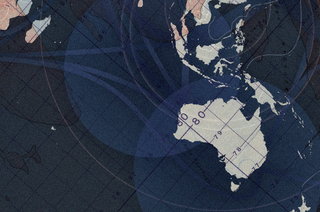Australians are avid consumers of US politics. But that doesn’t mean the vast majority are fans of the current president.
“I run the country and the world.” Donald Trump’s words echoed far beyond the reaches of Truth Social this week, even reaching Australian shores, albeit drowned out by the last frenetic week of the election campaign.
Trump-style politics has undeniably permeated Australia’s political culture during this election campaign — both in the way political parties are engaging with media and by shaping the soundbites they share. Most recently has come the revelation that one of the architects of Donald Trump’s 2024 victory claims he made an unpublicised visit to Australia to advise the Liberal Party about “structural issues” related to Peter Dutton ahead of the federal election.
Both major party leaders’ interviews with YouTubers and influencers have sparked comparisons to the US presidential race, where campaigns unfolded in podcast studios rather than on the debate stage. Opposition Leader Dutton in particular has been accused of drawing straight from Trump’s playbook in his push to scale back DEI (diversity, equity and inclusion) in the public service and add a new government efficiency portfolio to his shadow ministry to cut “wasteful spending” — though he later walked back many of his public service policies.
But politicians could be vastly misjudging the political landscape here. Australians are avid consumers of the spectacle of US politics. But that doesn’t mean the vast majority are fans of the current president. In recent weeks, the effects of Trump 2.0 have been felt close to home, as his “Liberation Day” tariffs continue to send shockwaves through global markets that are hitting Australians’ pockets and retirement planning.
This sentiment was soon picked up in focus groups and thus, throughout the campaign, Dutton has swung between emulating Trump’s rhetoric and distancing himself from the president — from claiming he could find ideological “common ground” with Trump and vowing to visit the US as his first official trip if elected, to sidestepping questions about Coalition Senator Jacinta Nampijinpa Price’s call to “make Australia great again.” Meanwhile, some third-party players have appeared less cautious about taking direct inspiration from the US president, with fringe billionaire candidate Clive Palmer launching the “Trumpet of Patriots” — a new political party with the explicit goal to “make Australia great again.”
However, a combination of structural factors means a Trump-like figure was always going to struggle to gain traction in an Australian context.
How Trump rose to power
As Trump stepped up to the lectern for his joint address to Congress earlier this year, the president basked in rapturous applause and chants from half the room. But he hasn’t always commanded such unwavering support from within his own party.
In 2016, Trump’s ascent from outsider to GOP standard-bearer stunned the Republican establishment. As Trump toppled a crowded field of far more seasoned and traditional political operatives, such as former Governor Jeb Bush and senator Marco Rubio, he provoked what many described as an all-out GOP “civil war”.
Establishment figures like Mitt Romney openly strategised about ways to deny the front-runner the nomination in an “anyone but Trump” plan. Trump publicly squabbled with party insiders like then speaker of the house Paul Ryan. Even after Trump had collected enough delegates to clinch the nomination, top Republican donors failed to throw their support behind his presidential campaign.
Yet the party machine wasn’t strong enough to deny Trump the Republican nomination nor the presidency.
In every presidential primary, hopefuls compete in state-by-state contests to lead their party to election. Factional opponents vie for voters and everyday Americans have direct influence over who emerges as the face of the party. A groundswell of grassroots public support was enough to carry Trump to the top of the Republican ticket despite a wall of fierce opposition from party elites. In America, individuals matter more than party structures.
But Australia’s “Washminster” democracy — a unique hybrid of political traditions that blends the Westminster parliamentary system with American-style federalism — does not operate in the same way. Ideological battles within the major parties are fought behind closed doors. And once a leader loses the confidence of their caucus, they are quickly ousted — as was the case for every Australian prime minister between 2007 and 2018, on both sides of the aisle.
Trump’s unique advantages
Of course, Trump’s “grievance” message would likely also struggle to find the same reception in an Australian setting.
In all three runs for the presidency, Trump capitalised on a widespread dissatisfaction with the status quo, and a palpable sense that working class Americans have been left behind by decades of economic neglect.
But Australia’s political culture and institutions create less fertile ground for grievance politics to thrive.
The country’s robust social safety net in part protects Australia from descending into US levels of inequality and economic disenfranchisement.
Compared to the “first-past-the-post” US political system, Australia’s preferential ballots encourage coalition- and consensus-building, rewarding politicians that appeal to the middle rather than extreme ends of the electorate. Mandatory voting is another bulwark against polarisation: 97% of Australia’s population is enrolled to vote — and only a small minority don’t turn out on election day.
The independence of Australia’s electoral management (compared to the openly partisan redistricting process used in the United States) drives higher trust in elections and their outcome. Westminster-style daily question time spurs more sustained public political engagement.
For all these reasons, Australian politics tends towards the centre. Polling in Trump’s first term found that Australia’s conservative base shared more ideological common ground with Hillary Clinton’s supporters than Trump voters. Three quarters of Australians hoped that Kamala Harris would triumph last November — and polling continues to suggest that Trump is almost politically toxic to Australian voters.
As President Trump moves at breakneck speed to reshape America’s institutions and role in the world, the spectacle of Trump 2.0 will continue to consume media oxygen in Australia. With Australia barreling towards its own federal election, commentators are sure to remain fixated on any signs of “Trumpism” creeping into Australian political discourse.
Trump’s reach and influence is undeniable. But perhaps the public’s fascination with US politics in part stems from just how out of place Trump’s tone and style would be in Australia’s own system.
Our political structures mean a similar outsider takeover of the Australian government by a polarising, Trumpian figure is unlikely to occur anytime soon. However, for now it is the very real economic effects of his policies that seem to be turning most Australians against the idea of Trump himself.





